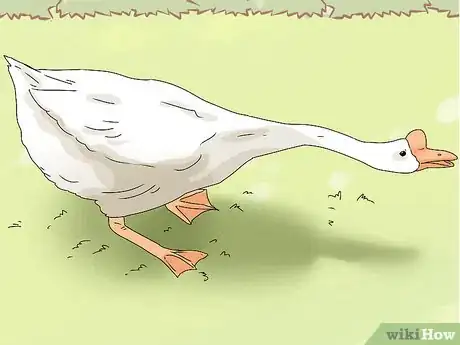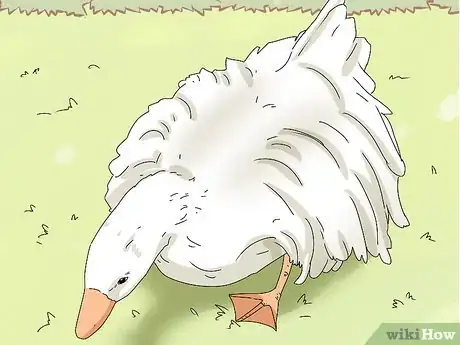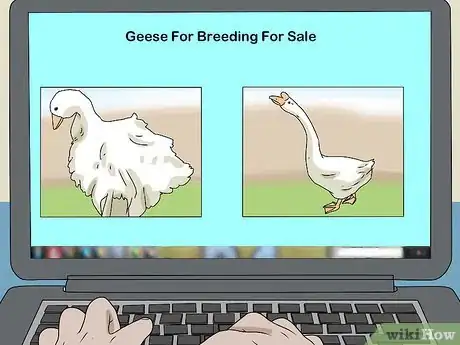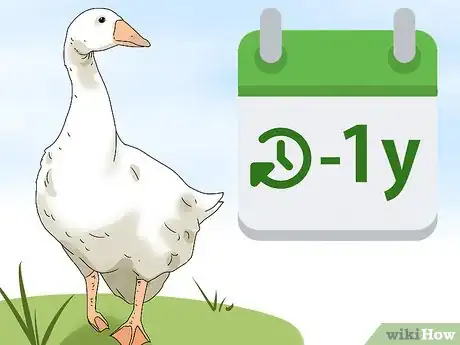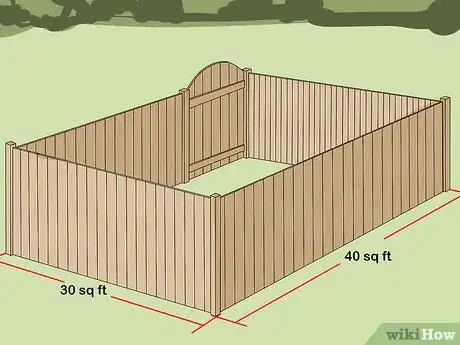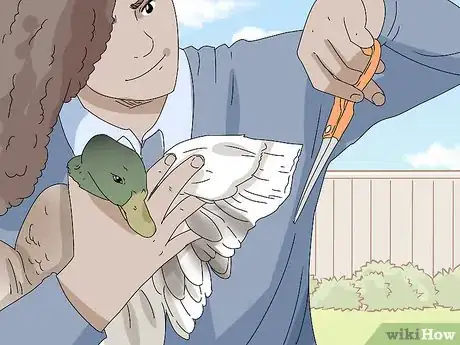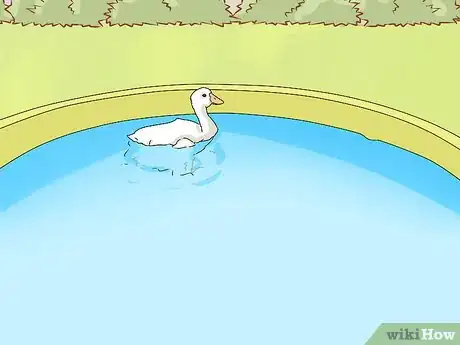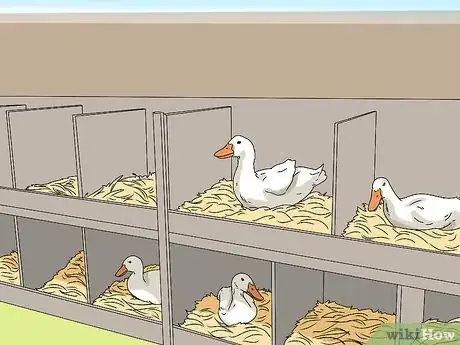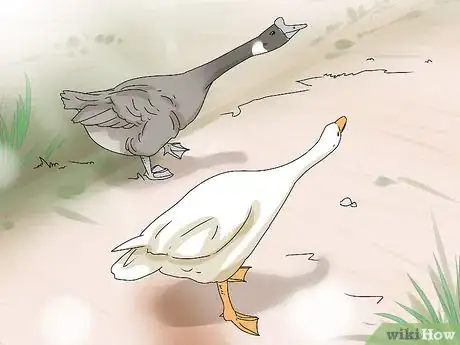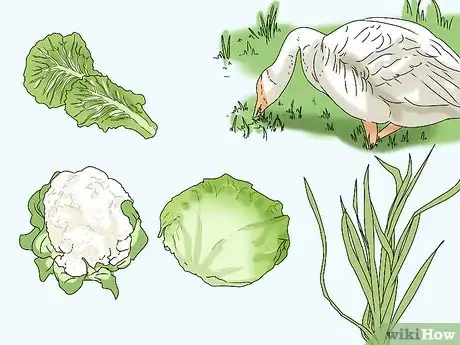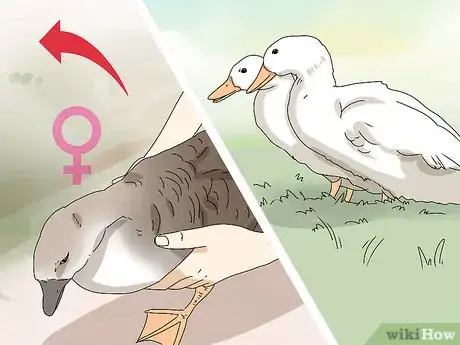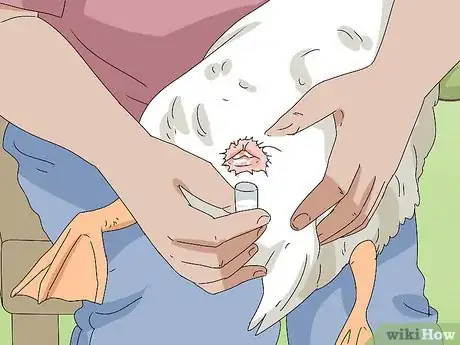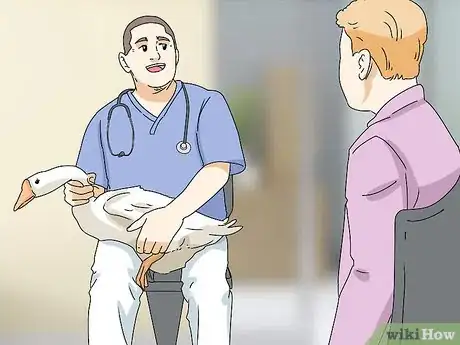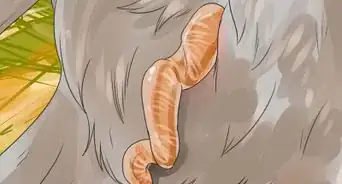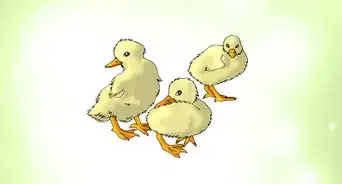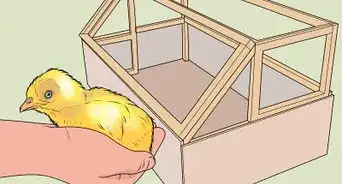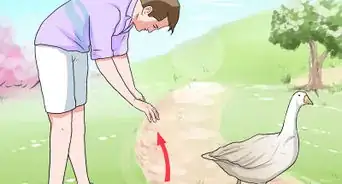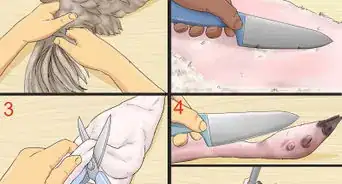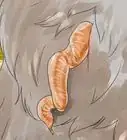This article was co-authored by wikiHow Staff. Our trained team of editors and researchers validate articles for accuracy and comprehensiveness. wikiHow's Content Management Team carefully monitors the work from our editorial staff to ensure that each article is backed by trusted research and meets our high quality standards.
There are 9 references cited in this article, which can be found at the bottom of the page.
This article has been viewed 47,851 times.
Learn more...
Raising and breeding your own geese is a fun and potentially lucrative thing to do. Geese lay large eggs and their meat is widely desired, which make them a great animal to breed. To breed a group, or gaggle, of geese on your own, decide on which kind of geese you want to breed, then purchase a few initial breeding geese. If you create the proper enclosure and care for the geese properly throughout the breeding season, your geese will likely begin to breed in no time.
Steps
Choosing the Right Geese
-
1Consider Toulouse or Emden geese if you want larger birds. Larger breeds of geese, like the Toulouse and Emden, weigh anywhere from 9–10 kilograms (20–22 lb) and can lay anywhere from 35-40 eggs per season. These geese are larger and are typically desired for their meat. If you have a lot of roaming space or a large enclosure and want larger birds, consider breeding these geese.[1]
- Toulouse geese have a large head with a small bill and large bodies with a prominent chest bone. They are typically different shades of gray with white edging around their feathers.
- Emden geese have all white feathers with broad, round bodies. Their eyes are light blue and their necks are long and swan-like.
-
2Get Chinese geese if you want smaller geese but more eggs. Smaller varieties like the Chinese geese are only 5.5–6 kilograms (12–13 lb) but can lay up to 50 eggs per season. Get these geese if you want to sell the eggs rather than the meat of the geese.[2]
- Chinese geese come in both brown and white variations. They are much smaller than European breeds of geese and have a knot, or protuberance, coming out from the base of their upper bill.
Advertisement -
3Consider Sebastopol geese if you want visually striking birds. Sebastopol geese have long, white curled feathers and a distinct color pattern on their face. Sebastopol geese are slightly smaller than Chinese geese and weigh anywhere from 5–5.5 kilograms (11–12 lb) and only lay 25-30 eggs per year. If you’re looking for a fancier type of geese, breed this bird.[3]
-
4Purchase strong, healthy geese for breeding. Search online for local geese breeders near you. It’s always best to purchase your geese in person because you can inspect them and ensure that they are healthy. A healthy goose will not be overweight or emaciated and will look vigorous and lively. They should have smooth feathers, strong legs, and no apparent physical damage or deformities.[4]
- If you can’t visit a breeder yourself, or there are none near you, you could purchase your geese online. Make sure to read the customer reviews of the farm before you buy your geese.
-
5Wait until the geese are at least 1 year old. While some breeders wait until the gaggle is 2 years of age, you can actually breed your geese when they are as young as 1. Before they reach maturity, they won’t be able to produce eggs.[5]
- Female geese can be kept until they are 10 years old, while male geese should be culled when they reach the age of 6.
-
6Have 1 gander for every 3-5 geese. The term for a male goose is a gander. Larger ganders, like the Toulouse and Emden, will typically only take on 1-3 mates in their lifetime while smaller variations like Chinese geese will take up to 5 mates. To improve your chances of breeding, make sure to get more female geese than male geese.[6]
- Occasionally, geese will be hard to breed because they may latch onto one mate and will be unwilling to mate with the other female geese.
Setting up the Geese’s Habitat
-
1Provide every 4 geese with an 14 ft × 20 ft (4.3 m × 6.1 m) enclosure. The enclosure should be an area that’s covered and safe from predators, such as a garden shed. This enclosed space is where your geese will sleep at night. If you are housing more geese, make sure to increase the size of the enclosure accordingly.[7]
- Herd the geese into the shed at night to keep them safe from predators like weasels and foxes.
- During the day, the geese should be kept in the outdoor space.
-
2Supply 30–40 sq ft (2.8–3.7 m2) of fenced outdoor space for each goose. On top of the indoor enclosure, you’ll need a place for your geese to roam around outside. Provide 30–40 square feet (2.8–3.7 m2) of outdoor roaming space per goose. The fence should be at least 6.5–7 feet (2.0–2.1 m) high so that your geese can’t escape. This will also prevent predators from getting into your geese’s habitat and eating them.[8]
- Since geese eat mostly grass, it’s best if the outdoor enclosure is covered in sweet grass that the geese can eat throughout the day.
-
3Clip the geese's wings if their outdoor space doesn't have a roof. If you just plan on using fencing along the perimeter of the geese habitat, the geese's wings will need to be clipped so they don't fly away. If you've never done this before, get an expert to help you the first time. To clip the bird's wings, you'll need to cut the 10 primary feathers, which are located on each wing towards the back of the bird.
- Chinese geese have limited flight ability so it's not necessary to clip their wings.
- Some believe that clipping a bird's wings is unethical. If you agree with this view, you can get an outdoor enclosure that has a roof, such as a wire cage.
- Your geese's feathers must be clipped once a year.
- Never cut feathers when they are coming in during molting. The feathers are filled with blood and are more like veins when they are first coming in.
- If done properly, clipping the wings will not hurt the geese.
-
4Allow access to adequate swimming water to encourage mating. While a swimming source isn’t necessary for breeding, it will encourage the geese to breed and will improve your chances of offspring. If the bird’s don’t have access to a freshwater pond, you can provide them a swimming space by filling up a children’s pool or large container with fresh water.[9]
- If kept in an enclosed space together, the geese should naturally start to mate once the mating season begins and they are mature.
-
5Provide one bird nest for every 4-5 geese. Geese enjoy enclosed spaces to lay their eggs. Find a 50 US gal (6,400 fl oz) or larger plastic tub and cut a hole that’s large enough so that your geese can go into it. Place the tub upside down so that the nest has a roof. Then, fill the bottom of the container with a 3–6 in (7.6–15.2 cm) layer of pine wood shavings or straw. This will provide a place for the geese to lay their eggs.[10]
- You can also use a barrel as the bird’s nest. Open the top of the barrel, then lay it down on its side and use wood wedges on both sides of the barrel to keep it in place and prevent it from rolling.
- If you’re using a wood barrel, you must also lay down nesting material.
Encouraging Mating
-
1Keep the geese together a month before the breeding season. The mating season typically happens at the beginning of the winter or spring, depending on the climate and where you live. To improve your chances of eggs and to increase the chance of fertility, acclimate your male and female geese a month before the mating season starts.[11]
- You can also start mating season later, but it may result in fewer eggs.
- Breeding season in North America usually occurs from February to March, so introduce your geese to each other in January.
- In Asia, breeding season occurs from February to June.
- In Europe, mating season occurs from May to July.[12]
-
2Feed your geese a balanced diet. The healthier your geese are, the more likely they will produce healthy eggs and mate. Geese diets mainly consist of eating grasses, sedges, cabbage leaves, cauliflower, lettuce, and eelgrass, which typically takes up around 70%-80% of their diet. While the geese will forage for bugs and plants, they should be provided with ample wheat or oat grain, once a day to supplement their diet.[13] Clean, fresh water should also be available to the gaggle at all times.[14]
- Chop up the lettuce into small pieces before feeding your geese.
- Provide each breeding goose with at least 200 grams (7.1 oz) of grain and 100 grams (3.5 oz) of vegetables per day.
- Replace old food so that it doesn’t get moldy.
-
3Remove females from the pen to see if the geese are mating. Remove one female from the pen and see how the gander reacts. If he doesn’t have any reaction, he's probably not mating with the goose that you removed from the pen. If the gander calls out, shakes its neck around, or looks agitated, it's probably already mated with the goose you removed.[15]
- If you have successful mating pairs, the goose will start laying eggs around a month after mating season.
-
4Use artificial insemination if you want more efficient breeding. If your geese are not naturally breeding or you want to improve the efficiency of breeding, you can artificially inseminate your geese. To do this, lay the gander on your lap, stimulate its genitalia, and collect its sperm in a cup. Then, inseminate the female bird by injecting the semen into the bird’s oviduct with a syringe.[16]
- If you don't have experience with artificial insemination, you should get someone experienced to help you the first time.
- Geese should be inseminated twice per week with 0.3 millilitres (0.010 fl oz) of semen.
- The geese will start laying eggs 3-5 days after insemination.
-
5Collect the goose eggs twice a day. Geese will typically start laying their eggs a month after the mating season begins and will continue laying eggs until the end of the mating season. Eggs should be collected at 6 a.m. - 9 a.m., then once more in the afternoon or evening. You should then start to incubate the eggs so that they hatch new baby geese.[17]
- You can also cook and eat unfertilized goose eggs.
- The type of geese that you’re breeding will dictate how many eggs they will lay per season on average.
- Geese will start laying eggs again during the next mating season.
-
6Take your gander to the vet if your geese aren’t mating. Sometimes, a goose will be lame, or unable to mate, because it is injured or has an infection. If you notice that your gander looks ill or isn’t mating, take it to a veterinarian to further diagnose the issue. The bird may need surgery or you may need to change something in its enclosure or its diet.[18]
- For instance, Staphylococcus is an injury and infection in the foot which prevents your goose from being mobile. An antibiotic must be injected into the bird to remedy it.
Community Q&A
-
QuestionWhat is the incubation period of geese?
 Community AnswerIncubation period for goose eggs is 32-36 days, about 36 and 1/2 days tops. If they are still not hatched by this time, they are infertile and will likely not hatch.
Community AnswerIncubation period for goose eggs is 32-36 days, about 36 and 1/2 days tops. If they are still not hatched by this time, they are infertile and will likely not hatch. -
QuestionHow can I sex adult geese?
 Community AnswerMost geese are semi-difficult to sex because the ganders and geese have very similar appearances. Usually, behavior is a strong indication of their sex, with males being loud and more assertive than females. With larger breeds, you generally have to wait until you get an egg or see them breeding to tell.
Community AnswerMost geese are semi-difficult to sex because the ganders and geese have very similar appearances. Usually, behavior is a strong indication of their sex, with males being loud and more assertive than females. With larger breeds, you generally have to wait until you get an egg or see them breeding to tell. -
QuestionAre ganders usually aggressive towards newly hatched goslings?
 Community AnswerNo, if aggressive to anything or anyone, it would be humans. Geese are normally excellent parents and the gander takes it as his personal responsibility to guard the goslings with his life.
Community AnswerNo, if aggressive to anything or anyone, it would be humans. Geese are normally excellent parents and the gander takes it as his personal responsibility to guard the goslings with his life.
References
- ↑ http://www.fao.org/docrep/005/Y4359E/y4359e03.htm
- ↑ http://www.fao.org/docrep/005/Y4359E/y4359e03.htm
- ↑ https://www.dpi.nsw.gov.au/animals-and-livestock/poultry-and-birds/species/geese-raising/breeds-and-breeding
- ↑ https://www.dpi.nsw.gov.au/animals-and-livestock/poultry-and-birds/species/geese-raising/breeds-and-breeding
- ↑ https://www.dpi.nsw.gov.au/animals-and-livestock/poultry-and-birds/species/geese-raising/breeds-and-breeding
- ↑ https://www.dpi.nsw.gov.au/animals-and-livestock/poultry-and-birds/species/geese-raising/breeds-and-breeding
- ↑ https://poultrykeeper.com/general-waterfowl/beginners-guide-keeping-geese/
- ↑ https://poultrykeeper.com/general-waterfowl/beginners-guide-keeping-geese/
- ↑ https://www.dpi.nsw.gov.au/animals-and-livestock/poultry-and-birds/species/geese-raising/breeds-and-breeding
- ↑ http://learningstore.uwex.edu/assets/pdfs/A3311.pdf
- ↑ http://learningstore.uwex.edu/assets/pdfs/A3311.pdf
- ↑ http://www.npolar.no/en/species/brent-goose.html
- ↑ https://casanctuary.org/wp-content/uploads/2017/01/Duck-and-Goose-Fact-Sheet.pdf
- ↑ https://www.dpi.nsw.gov.au/animals-and-livestock/poultry-and-birds/species/geese-raising/feeding-geese
- ↑ https://www.dpi.nsw.gov.au/animals-and-livestock/poultry-and-birds/species/geese-raising/breeds-and-breeding
- ↑ http://www.fao.org/docrep/005/Y4359E/y4359e09.htm
- ↑ http://learningstore.uwex.edu/assets/pdfs/A3311.pdf
- ↑ https://poultrykeeper.com/skeletal-and-muscular-disorders/lameness/

